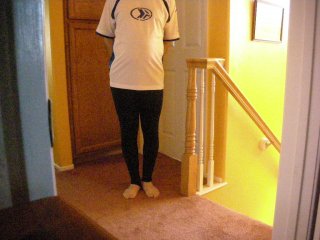[
Leggings in various forms and under various names have been worn for warmth and protection by both men and women throughout the centuries. The separate
hose worn by men in Europe from the 14th to 16th centuries (the
Renaissance period) were a form of leggings, as are the
trews of the
Scottish Highlands. Separate leggings of buckskin leather were worn by some
Native Americans; These were adopted by some Long Hunters, French fur trappers, and later by
mountain men. They are the
leatherstockings of
James Fenimore Cooper's
Leatherstocking Tales. The Buckskins, however were mostly a dull grey
brain-tan, not the bright, glossy
vegetable tanned leather we so commonly see today. It was also common for leggings to be made of light wool.
In many places, especially in colder countries such as ex:
Russia or
Korea men and women continued to wear wool leggings into modern times, often as an additional outer layer for warmth.
The linen
pantalettes worn by girls and women under
crinolines in the mid-19th century were also a form of leggings, and were originally two separate garments.
Leggings became a part of fashion in the 1960s, as trousers similar to the
capris pants but much tighter.
It was not until the fitness and aerobics craze in the very early 1980s that leggings became fashionable as gym-styled street wear for women.
[
[edit] Modern leggings
Leggings in the form of skin-tight trousers, a tighter version of the
capris ending at mid-calf or near ankle length, made its way into fashion in the 1960s and were worn with a large belt and slip-on high heels or ballet flat-styled shoes.
Leggings made from a nylon-lycra blend (usually 90% nylon, 10% lycra) are traditionally worn for exercise, although beginning in the
1980s they have also been worn for fashion. Nylon lycra leggings are often referred to as bicycle or running tights, and are shinier in appearance than those made from cotton. Many have racing stripes or reflective patterns to further distinguish them as athletic wear and provide extra safety.
Leggings made from cotton-lycra, or a cotton-polyester-lycra combination, are more typically worn for fashion, but are also common as fitness apparel as well. Although cotton lycra leggings can come in many colors, black, navy, and various shades of gray remain the most commonly worn. Leggings may also come in a variety of colorful prints and designs.
Leggings are typically ankle-length; they are occasionally stirrupped, or less commonly, footed.
Because of their comfort and attractive appearance, leggings quickly found their way out of the fitness clubs and into everyday casualwear.
Wearing black leggings under long, often diaphanous, skirts was part of a general fashion trend of wearing gym or dance clothes as street wear that evolved along with the fitness craze and under the influence of the movie
Flashdance and the long-running
Broadway show
A Chorus Line. A more recent trend pairs black leggings with short skirts.
By the early-1990s, leggings were actually outselling
jeans in many parts of the United States, but a backlash of sorts occurred in the mid-late '90s regarding the clothing item. Men have also begun to wear leggings more frequently in recent years as long underwear, and for more casual physical activities such as walking, hiking or gardening, replacing the old standby, sweatpants. Leggings are also worn as a fashion trend by men on the London electro-music scene.
In 2005, leggings began to make a "comeback" into the world of
high fashion by pairing
capri-length leggings with mini skirts with this resurgence continuing into 2006 and 2007. This resurgence coincided with the popularity of
boho-chic as a general style of fashion. Consequently, leggings are also now popular to wear with oversized, long sweaters. This trend towards tight pants can alternately be seen in the resurgence of
skinny jeans.
At the Marni Men's show during the Fall 2007 Fashion Week, outfits with leggings designed solely for men were introduced.
[1]
http://en.wikipedia.org/wiki/Hosieryhttp://en.wikipedia.org/wiki/Image:Blackholdups.jpghttp://en.wikipedia.org/wiki/Loose_socks
 ill try n get pictures ... btw i go to an arts college.. which has a massive fashion department so people are very shall we say .. experimental
ill try n get pictures ... btw i go to an arts college.. which has a massive fashion department so people are very shall we say .. experimental ill try n get pictures ... btw i go to an arts college.. which has a massive fashion department so people are very shall we say .. experimental
ill try n get pictures ... btw i go to an arts college.. which has a massive fashion department so people are very shall we say .. experimental











 nothing to do with fashion)
nothing to do with fashion)





